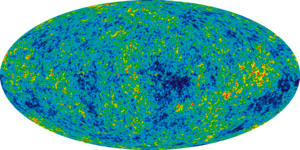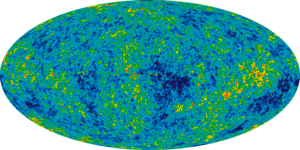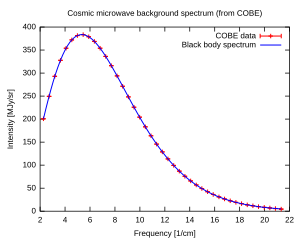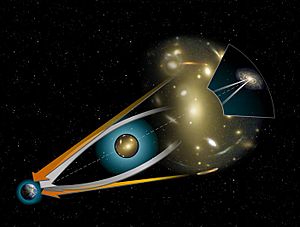Cosmic microwave background facts for kids

| Physical cosmology | ||||||||||||||
 |
||||||||||||||
| Universe · Big Bang Age of the universe Timeline of the Big Bang Ultimate fate of the universe
|
||||||||||||||
The cosmic microwave background (often called CMB) is a faint glow of microwave radiation that fills all of space. Think of it as a leftover "echo" from the very early universe. It's a super important clue that helps scientists understand how our universe began.
If you look at space with a regular telescope, it seems mostly dark between stars and galaxies. But a special radio telescope can find a soft glow everywhere. This glow is almost perfectly uniform and isn't linked to any star or galaxy. It's strongest in the microwave part of the radio spectrum. Two American radio astronomers, Arno Penzias and Robert Wilson, accidentally found the CMB in 1965. This discovery was a big step in understanding the universe.
The CMB is strong proof for the Big Bang theory, which explains how the universe started. According to the Big Bang model, the early universe was like a thick, hot fog of tiny particles called plasma. As the universe grew, this plasma cooled down. Eventually, protons and electrons joined to form neutral atoms, mostly hydrogen. Unlike the hot plasma, these new atoms didn't scatter light. So, the universe became clear! This moment is called "recombination" or "decoupling". It allowed photons (light particles) to travel freely through space. These photons are sometimes called "relic radiation" because they are leftovers from that time. Over billions of years, the universe has kept expanding. This expansion has stretched the light waves, making the photons less energetic. This stretching is called cosmological redshift. The "surface of last scattering" is like a giant bubble around us. The light we see from the CMB today started its journey from this bubble when the universe first became clear.
The CMB isn't perfectly smooth. It has tiny, faint differences, like ripples, that sensitive detectors can map. Space missions like COBE, WMAP, and Planck have measured these temperature changes. These ripples show how matter and light interacted before the universe became clear. They create a lumpy pattern that changes with how big an area you look at. Scientists study these patterns to learn about the early universe. For example, the first big ripple tells us about the overall shape of the universe. Other ripples give clues about how much normal matter and dark matter exist. It can be tricky to get all the details from CMB data because things like galaxy clusters in front of it can change the signal.
Contents
What is the CMB Like?
The cosmic microwave background radiation is a uniform glow of black body thermal energy coming from every direction. We measure its strength in kelvin (K), which is a unit of temperature. The CMB has a temperature of about 2.725 K. Any changes in its strength are shown as small changes in this temperature.
This radiation is incredibly uniform across the sky. It's very different from the bright, point-like stars or clumps of stars in galaxies. The radiation is almost perfectly isotropic, meaning it's the same in all directions. The tiny differences are only about one part in 25,000. This is after removing a slight "dipole" effect. This dipole effect is caused by our Sun moving through space. Our Sun moves at about 370 kilometers per second towards the constellation Crater.
Even though the CMB is very uniform, measuring its tiny differences with high accuracy is super important. These measurements help us test and improve our theories about the universe.
Besides temperature differences, the CMB should also have changes in its polarization. Polarization describes the direction that light waves vibrate. There are two main types: E-mode and B-mode polarization. The E-mode signal is about 10 times weaker than the temperature differences. It adds more information to the temperature data. The B-mode signal is even weaker, but it might hold even more important clues about the early universe.
The CMB contains most of the photons in the universe. There are about 400 CMB photons for every single photon from stars or galaxies! The number of CMB photons is a billion times (109) more than the number of matter particles in the universe. If the universe hadn't expanded and cooled the CMB, the night sky would be as bright as the Sun!
How Was the CMB Discovered?
Early Ideas
In 1931, a scientist named Georges Lemaître thought that leftover radiation from the early universe might still be around. But he thought it would be cosmic rays. In 1934, Richard C. Tolman showed that if the universe expanded, any heat radiation would cool down but still keep its thermal pattern.
The cosmic microwave background was first predicted in 1948 by Ralph Alpher and Robert Herman. They were working on a paper with George Gamow. Alpher and Herman guessed that the CMB's temperature would be about 5 K. They were pretty close!
The Big Discovery

In 1964, Arno Penzias and Robert Woodrow Wilson were working at Bell Telephone Laboratories in New Jersey. They had built a special antenna, called a Dicke radiometer. They planned to use it for radio astronomy and satellite communication. This antenna was first built in 1959 for Project Echo. That project used large balloons in space to bounce radio signals around the Earth.
On May 20, 1964, Penzias and Wilson made their first measurement. It clearly showed a microwave background. Their instrument picked up an extra "noise" that they couldn't explain. It was like a constant hiss. They tried everything to get rid of it. They even cleaned pigeon droppings out of the antenna, thinking that was the problem!
After talking to other scientists, they realized what they had found. This "noise" was exactly what scientists at Princeton University were looking for. It was the cosmic microwave background. Penzias and Wilson won the Nobel Prize in Physics in 1978 for their amazing discovery.
Where Did it Come From?
In the late 1960s, scientists debated what the CMB really was. Some thought it might come from our solar system, or from galaxies. But two things proved it was truly "cosmic":
- Its energy pattern matched a "thermal" or "blackbody" source. This was confirmed by 1968.
- It was the same from all directions (isotropic). This was confirmed by 1970.
These proofs showed that the radiation really came from the entire universe.
How the CMB Supports the Big Bang Theory
The cosmic microwave background radiation, along with the expansion of the universe, are the strongest pieces of evidence for the Big Bang theory. Measurements of the CMB have helped make the Big Bang model, which includes inflation, the main way scientists understand the universe. When the CMB was discovered in the 1960s, it greatly reduced interest in other ideas, like the steady state theory.
In the Big Bang model, the universe started very hot and dense. About 10-37 seconds after the Big Bang, the universe went through a super-fast growth spurt called cosmic inflation. This made the universe incredibly smooth. Any tiny bumps left over were from quantum fluctuations. Long before stars and planets formed, the early universe was much smaller, hotter, and filled with a bright glow. This glow came from a hot fog of interacting particles: photons, electrons, and baryons (protons and neutrons).
As the universe expanded, it cooled down. This cooling made it possible for electrons to combine with protons, forming neutral hydrogen atoms. This "recombination" event happened when the universe was about 379,000 years old. At that time, the temperature was around 3000 K. Since photons didn't interact with these neutral atoms, they started to travel freely through space. This is called the "decoupling" of matter and radiation.
Since then, the temperature of these free photons has kept dropping. Now it's about 2.726 K. It will keep dropping as the universe expands. The light we measure today from the sky comes from a spherical "surface of last scattering." This is where the decoupling event happened. Most of the energy in the universe is in the cosmic microwave background.
Two of the biggest successes of the Big Bang theory are:
- Its prediction that the CMB would have an almost perfect black body spectrum.
- Its detailed prediction of the tiny differences (anisotropies) in the CMB.
The CMB spectrum is now the most precisely measured black body spectrum in nature.
Tiny Ripples in the CMB
The tiny differences, or anisotropies, in the cosmic microwave background are divided into two types:
- Primary anisotropy: These are differences that happened at the "surface of last scattering" or even earlier.
- Secondary anisotropy: These are differences caused by things that happened after the light started traveling freely. For example, hot gas or changing gravity fields can affect the CMB photons.
The pattern of these CMB ripples is mainly shaped by two things:
- Acoustic oscillations: Imagine sound waves in the early universe! The pressure from photons tried to smooth out any bumps. But the gravity of baryons (normal matter) tried to pull them together into denser spots. These two forces fought each other, creating "acoustic oscillations." These oscillations give the CMB its special peak pattern. Each peak tells us something important. For example, the first peak tells us about the shape of the universe. The second and third peaks give clues about the density of normal matter and dark matter.
- Diffusion damping: This effect smooths out the very smallest ripples. It happens because photons could travel further as the universe expanded and became less dense.
The "depth" of the last scattering surface means that the decoupling didn't happen instantly. It took a while. Scientists have figured out that the time when a CMB photon was most likely to have last scattered was about 372,000 years after the Big Bang. But the whole process of decoupling took about 115,000 years. So, by the time it was complete, the universe was roughly 487,000 years old.
Later Changes to the CMB
Since the CMB was created, it has been changed by other things. These are called "late-time anisotropy" or "secondary anisotropy." After the CMB photons became free, most of the matter in the universe was neutral hydrogen and helium atoms. But today, we see that most of the space between galaxies is filled with ionized material (atoms that have lost their electrons). This means there was a time when the universe was "reionized."
CMB photons can be scattered by free electrons. If the universe was ionized very early on, when it was still denser, two main things happened to the CMB:
- Small ripples were erased, making them fuzzy.
- The scattering of photons by free electrons created polarization differences on large scales.
Both of these effects have been seen by the WMAP spacecraft. This shows that the universe was reionized very early. Scientists are still studying what caused this early reionization. It might have been light from the very first stars, or from massive black holes.
The time after the CMB was emitted but before the first stars appeared is sometimes called the "Dark Age" of the universe. Scientists are studying this period a lot.
Other effects that changed the CMB include:
- The Sunyaev–Zeldovich effect: When high-energy electrons in galaxy clusters scatter CMB photons, giving them more energy.
- The Sachs–Wolfe effect: When CMB photons gain or lose energy as they travel through changing gravity fields.
CMB Polarization
The cosmic microwave background is polarized, but only by a tiny amount. There are two types of polarization: E-mode and B-mode.
E-modes
E-modes are created when CMB photons scatter off particles in the early, uneven plasma. E-modes were first detected in 2002 by the Degree Angular Scale Interferometer (DASI).
B-modes
B-modes are expected to be much weaker than E-modes. They are not created by the usual small bumps in the early universe. Instead, they are thought to be made by gravitational waves. These waves are ripples in space-time that might have been created during cosmic inflation right after the Big Bang.
However, a process called "gravitational lensing" can also create B-modes. This happens when the gravity of large cosmic structures bends the light from the stronger E-modes. So, finding the original B-modes from gravitational waves is hard because you have to separate them from the B-modes caused by lensing.
Gravitational Waves from the Early Universe
Theories of "slow-roll" cosmic inflation predict that the very early universe had primordial gravitational waves. These waves would leave a special pattern of B-mode polarization in the CMB. Finding this pattern would be huge proof for the theory of inflation. It could also help scientists figure out which inflation models are correct.
In 2014, the BICEP2 experiment thought they had found this B-mode pattern. But later, new results from the Planck experiment showed that the signal was mostly from cosmic dust in our own galaxy, not from the early universe.
Gravitational Lensing B-modes
The second type of B-modes, those caused by gravitational lensing, was discovered in 2013. This was done using the South Pole Telescope with help from the Herschel Space Observatory. In 2014, the POLARBEAR experiment also published measurements of B-mode polarization. POLARBEAR looked at a smaller part of the sky and was less affected by dust. They reported that their B-mode polarization was indeed from a cosmic source.
What Will Happen to the CMB in the Future?
If the universe keeps expanding forever and doesn't end in a Big Crunch or Big Rip, the cosmic microwave background will continue to stretch and cool. Eventually, it will become so faint and spread out that we won't be able to detect it anymore. It will be replaced by light from stars, and much, much later, by radiation from other processes that might happen in the far future of the universe, like proton decay or evaporation of black holes.
See also
 In Spanish: Radiación de fondo de microondas para niños
In Spanish: Radiación de fondo de microondas para niños
- Axis of evil (cosmology)
- Cosmic neutrino background
- Cosmic microwave background spectral distortions
- Cosmological perturbation theory
- Gravitational wave background
- Heat death of the universe
- Horizons: Exploring the Universe
- Lambda-CDM model
- List of cosmological computation software
- Non-standard cosmology
- Observational cosmology
- Observation history of galaxies
- Physical cosmology
- Timeline of cosmological theories



